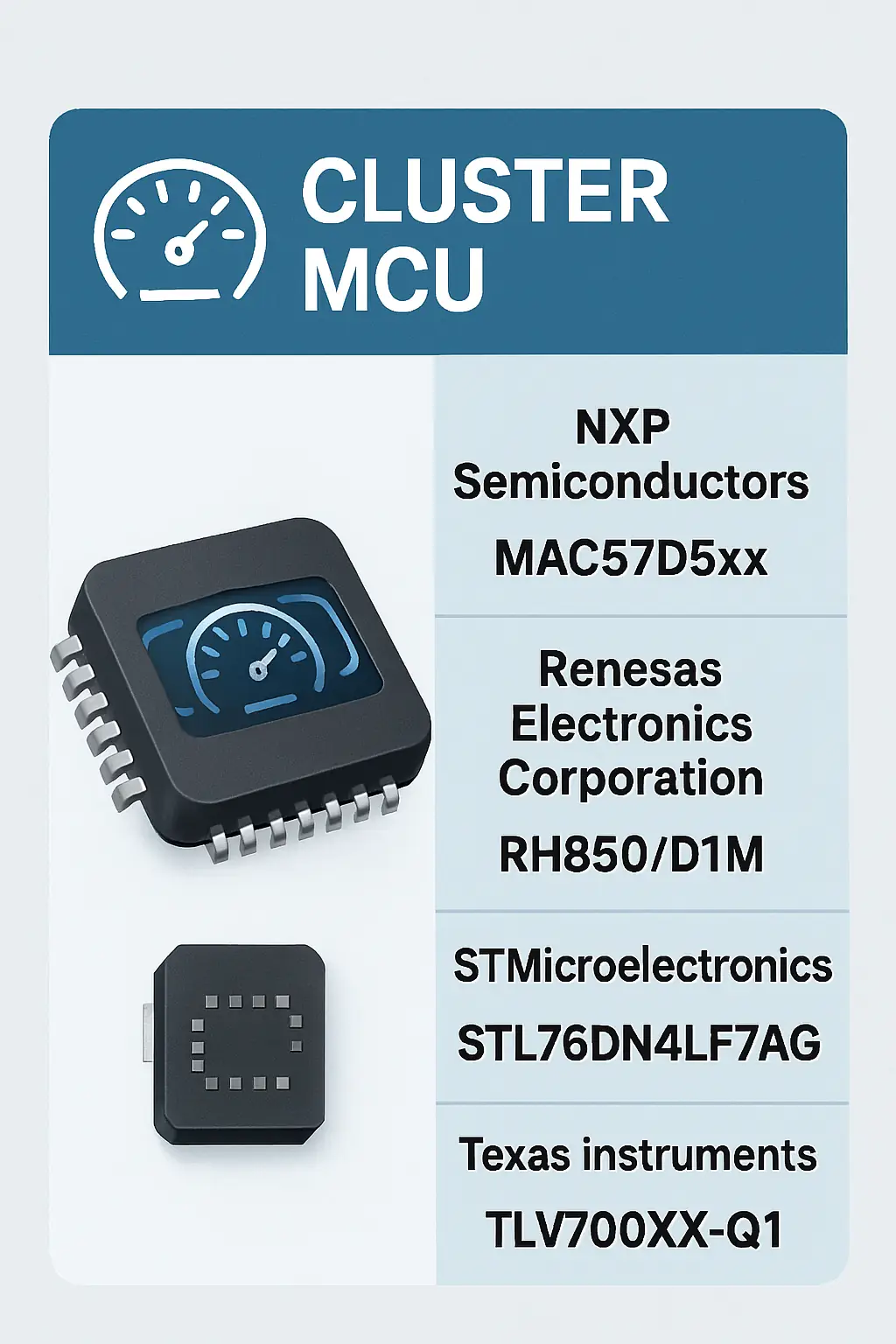Cluster MCU
The Cluster MCU (Microcontroller Unit) is a critical component within the Digital Cluster & Display subsystem of an Infotainment & Digital Cockpit system in modern Automotive Electronics. It serves as the central processing unit responsible for managing and controlling the vehicle's instrument cluster, which includes speedometer, tachometer, fuel gauge, and other essential driver information displays.
This MCU processes data from various sensors and systems across the vehicle, such as engine performance, vehicle speed, and warning signals, and then displays this information in a clear and user-friendly format on the digital dashboard. It ensures real-time accuracy, reliability, and safety by integrating with other vehicle systems through standardized communication protocols like CAN or LIN.
The Cluster MCU is widely used in advanced driver assistance systems (ADAS), electric vehicles (EVs), and connected cars, where high-performance and low-latency processing are essential. It supports customizable display configurations, allowing manufacturers to tailor the user interface according to brand identity and user preferences.
In addition to basic instrumentation, the Cluster MCU can also manage warning lights, driver alerts, and even integrate with infotainment systems for a seamless in-vehicle experience. Its role is vital in enhancing driver awareness, improving usability, and contributing to overall vehicle safety and performance. This component is essential for the development of next-generation smart vehicles with enhanced digital interfaces and intelligent driving features.
Details
Cluster MCU

Related Parts
| Series Name | Description | Manufacturer Name | Attribute Description |
|---|---|---|---|
| NXP Semiconductors | Input voltage: 2.7V to 5.5V; Output current: up to 1.2A; Switching frequency: 3MHz; Efficiency: up to 95%; Operating temperature: -40°C to +125°C; Package: WLCSP-12. | ||
| NXP Semiconductors | 32-bit ARM Cortex-M7 core, up to 180 MHz, 2 MB Flash, 256 KB RAM, 12-bit ADC, CAN-FD, Ethernet, FlexRay, motor control peripherals, safety & security features. | ||
| NXP Semiconductors | 32-bit Power Architecture core, up to 64 MHz, 1.2V core voltage, 512 KB flash, 64 KB RAM, -40°C to 125°C operating temperature, 100-pin LQFP package, supports CAN, LIN, SPI, and PWM interfaces. | ||
| NXP Semiconductors | 24-channel FET driver, 1.8A sink current, 12-bit PWM dimming, I²C interface, 3.3V/5V operation, 0 to 40 V output, 1 MHz clock, 2.3 mm × 3.3 mm TSSOP24 package. | ||
| NXP Semiconductors | 32-bit Power Architecture core, up to 120 MHz, 2 MB Flash, 192 KB RAM, supports automotive applications with ASIL-D safety, integrated e200z core, multiple CAN, LIN, FlexRay interfaces. | ||
| NXP Semiconductors | Quad-core ARM Cortex-A53, single-core Cortex-M4, up to 1.5GHz; integrated GPU, 8-bit DDR3/LPDDR4 support, 4K video decode, multiple display outputs, PCIe, USB 3.0, MIPI CSI/DSI, Gb Ethernet. | ||
| Renesas Electronics Corporation | 32-bit MCU, 400 MHz CPU, up to 8 MB Flash, 2 MB RAM, 24-channel PWM, 12-channel ADC, CAN FD, Ethernet, supports ASIL-D safety, suitable for automotive applications. | ||
| Renesas Electronics Corporation | 32V, 2A synchronous buck controller; 500kHz switching frequency; input voltage 4.5V to 32V; output adjustable down to 0.8V; integrated high-side MOSFET driver. | ||
| STMicroelectronics | N-channel 75V, 80A, 4.5mΩ typ. RDS(on), 10V VGS, TO-220FP package, suitable for power management and motor control applications. | ||
| STMicroelectronics | 3.3V fixed low-dropout voltage regulator, 1.5A output current, 4.5V to 26V input voltage range, low quiescent current, thermal and overcurrent protection, available in TO-220 and D²PAK packages. |








.png?x-oss-process=image/format,webp/resize,h_32)










